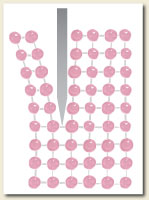Finger slayer

I still have all my fingers. But that is thanks to the Demiurge and not my smarts. Three hours in the emergency room and five stitches later I was back to the kitchen. How a knife cuts so well is one of the wonders of material science. Steel is not a neat arrangement of atoms, but a complicated structure. The strength of the steel is what allows the atoms of one material to tear through another (like a block of cheese or an unfortunate finger).
The physics of how this works is recent. Tony Atkins from the University of Reading explained it in a 2003 article. At first it appears simple. You have a block of cheese, the knife goes through it and you end up with two blocks. Some energy goes into overcoming the friction of rubbing the knife against the cheese, some of the energy into fracturing the cheese to create new surfaces, and some energy into deforming the cheese as it gets cut.

The energy for creating the new surfaces was the problem. There is a thermodynamic quantity called the surface energy, a version for solids of the surface tension in liquids. Surface energy is measured in experiments that determine how much force is needed to change the total surface area of a solid. Heat a wire, add weights to it, and see how it stretches would be a common way to measure surface energy. The problem is that this energy has little to do with the energy of breaking the bonds between atoms. The surface energy is about 1000 times smaller than the energy to crack open a new surface.
Food played a role in Atkins’ discovery. Atkins has been interested in cutting since the 1970s. Recent funding from the DEFRA of the United Kingdom gave him and his colleagues a chance to revisit the science behind cutting and to conduct experiments. One of the discoveries was a resolution of a mystery: why is it easier to cut if one also slides the knife instead of just pushing it down?


Slicing is one of those Archimedes-style simple machines. The knife exerts a downward force. Its edge has the shape of a wedge (two inclined planes) and transmits part of that force in the horizontal direction. The tip of the edge is very thin, which concentrates the pressure. (The edge of a knife is around 1 micron in thickness, about 2000 times thinner than the blade.) While the tip of the knife is fracturing a carrot or a block of cheese, there will be friction against the sides of the knife. Sliding the knife back and forth does not exert pressure downwards and increases the amount o friction, so at first it is a mystery why it seems to help with cutting.
Atkins and collaborators observed in an experiment that it is the total work done by the knife that matters in computing the energy balance in cutting. The horizontal component of the motion is found to contribute to the fracture and diminish the needed force downwards. The exact mechanism is not known, but it must be that the horizontal force is also creating fractures.
The creation of small fractures that grow into a cut can only happen because the knife is made of a hard material that can withstand the downwards forces without edge bending. Stress with little strain is the wonder of steel. Steel is made from iron by adding small amounts of other metals and also carbon. Depending on how much carbon is mixed in and how the mixture is heated and then cooled, different materials can form (the many phases of steel).
The composition of the steel used in commercial knifes is kept a secret, but it has between 0.15 to 0.5 percent of carbon and between 12 to 15 percent of chromium. Part of the carbon reacts with the iron to form iron carbide or cementite, a material that on its own is very hard but brittle. The rest of the carbon dissolves in the iron, just as sugar dissolves in water. The dissolved carbon prevents layers of iron from sliding around, making the steel harder.
How not to cut yourself, how to use a laser to check your knife and other wonders of the kitchen friend after I post my apple lavender entry.